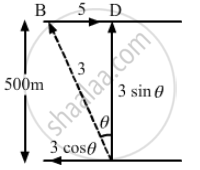Advertisements
Advertisements
प्रश्न
Consider the situation of the previous problem. The man has to reach the other shore at the point directly opposite to his starting point. If he reaches the other shore somewhere else, he has to walk down to this point. Find the minimum distance that he has to walk.
उत्तर
Given:
Width of the river = 500 m
Rate of flow of the river = 5 km/h
Swimmer's speed with respect to water = 3 km/h
As per the question, the man has to reach the other shore at the point directly opposite to his starting point.

Horizontal distance is BD for the resultant velocity vr.
x-component of the resultant velocity, R = 5 - 3 cos θ
Vertical component of velocity = 3 sin θ km/h
\[\text{ Time } = \frac{\text{ Distance } }{\text{ Velocity } } = \frac{0 . 5}{3\sin\theta} h\]
This is the same as the horizontal component of velocity.
Thus, we have:
\[BD = \left( 5 - 3 \cos \theta \right) \left( \frac{0 . 5}{3\sin \theta} \right)\]
\[ = \frac{5 - 3 \cos \theta}{6 \sin \theta}\]
For H (horizontal distance) to be minimum,
⇒ −30 cos θ = 18
\[\Rightarrow \cos \theta = - \frac{18}{30} = - \frac{3}{5}\]
\[\text{ Negative sign shows that } \theta \text{ lies in the 2nd Quadrant .} \]
\[ \text{ And }, \]
\[\sin \theta = \sqrt{1 - \cos^2 \theta } = \frac{4}{5}\]
\[ \therefore H = \frac{5 - 3 \cos \theta}{6 \sin \theta}\]
\[ = \frac{5 - 3\left( \frac{3}{5} \right)}{6 \times \frac{4}{5}} = \frac{25 - 9}{24}\]
\[ = \frac{16}{24} = \frac{2}{3} \text{ km }\]
APPEARS IN
संबंधित प्रश्न
A car moving along a straight highway with a speed of 126 km h–1 is brought to a stop within a distance of 200 m. What is the retardation of the car (assumed uniform), and how long does it take for the car to stop?
A boy standing on a stationary lift (open from above) throws a ball upwards with the maximum initial speed he can, equal to 49 m/s. How much time does the ball take to return to his hands? If the lift starts moving up with a uniform speed of 5 m/s and the boy again throws the ball up with the maximum speed he can, how long does the ball take to return to his hands?
At which point on its path a projectile has the smallest speed?
In a projectile motion the velocity
A particle starting from rest moves with constant acceleration. If it takes 5.0 s to reach the speed 18.0 km/h find the distance travelled by the particle during this period.
A driver takes 0.20 s to apply the brakes after he sees a need for it. This is called the reaction time of the driver. If he is driving a car at a speed of 54 km/h and the brakes cause a deceleration of 6.0 m/s2, find the distance travelled by the car after he sees the need to put the brakes on.
A police jeep is chasing a culprit going on a motorbike. The motorbike crosses a turning at a speed of 72 km/h. The jeep follows it at a speed of 90 km/h, crossing the turning ten seconds later than the bike. Assuming that they travel at constant speeds, how far from the turning will the jeep catch up with the bike?
A ball is projected vertically upward with a speed of 50 m/s. Find the maximum height.
A stone is thrown vertically upward with a speed of 28 m/s. Find the maximum height reached by the stone.
A stone is thrown vertically upward with a speed of 28 m/s.Find its velocity one second before it reaches the maximum height.
A stone is thrown vertically upward with a speed of 28 m/s. change if the initial speed is more than 28 m/s such as 40 m/s or 80 m/s ?
A person sitting on the top of a tall building is dropping balls at regular intervals of one second. Find the positions of the 3rd, 4th and 5th ball when the 6th ball is being dropped.
A ball is thrown horizontally from a point 100 m above the ground with a speed of 20 m/s. Find the time it takes to reach the ground .
A ball is thrown at a speed of 40 m/s at an angle of 60° with the horizontal. Find the maximum height reached .
A ball is thrown at a speed of 40 m/s at an angle of 60° with the horizontal. Find the range of the ball. Take g = 10 m/s2.
A ball is projected from a point on the floor with a speed of 15 m/s at an angle of 60° with the horizontal. Will it hit a vertical wall 5 m away from the point of projection and perpendicular to the plane of projection without hitting the floor? Will the answer differ if the wall is 22 m away?
A river 400 m wide is flowing at a rate of 2.0 m/s. A boat is sailing at a velocity of 10 m/s with respect to the water, in a direction perpendicular to the river. Find the time taken by the boat to reach the opposite bank.
A river 400 m wide is flowing at a rate of 2.0 m/s. A boat is sailing at a velocity of 10 m/s with respect to the water, in a direction perpendicular to the river. How far from the point directly opposite to the starting point does the boat reach the opposite bank?
